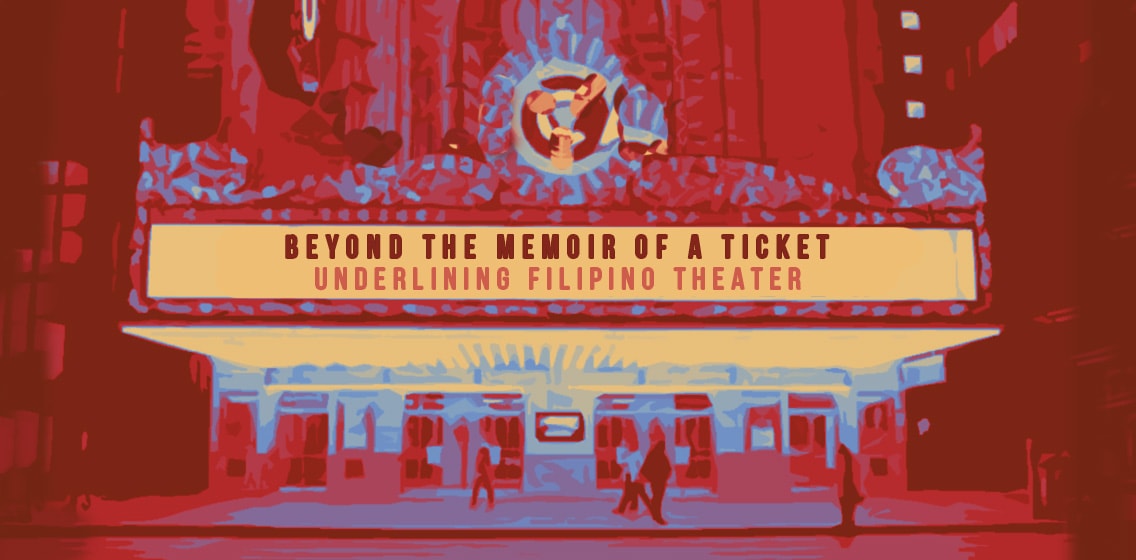Beyond the memoir of a ticket: Underlining Filipino theater
You might have already heard famous songs from musicals in Broadway and West End such as Les Miserables’ On My Own, Miss Saigon’s I Still Believe, Wicked’s Defying Gravity, and many more that made us fall in love with the essence and existence of theater. Despite our adoration for Western stage plays, some of us are unfortunately unaware of the rich cultural dimensions of our own underrated Pinoy Theater productions of Tanghalang Filipino, Philippine Educational Theater Association, Repertory Philippines, and other theater groups hiding in the corners of metropolis.
Join us as we utilize our backstage pass for the culture of Pinoy Theater, and visit the dressing room of its constituents—and their struggles behind the stage.

One does not simply refute the fact that the Philippines has been blessed with legendary artists in the field of music, art, theater, and acting. Just consider those who conquered Broadway and West End like Lea Salonga, Joanna Ampil, Tanya Manalang, Rachel Ann Go, and Jon Jon Briones—rare talented artists who managed to step on the platform of universal fame. As is commonly the case, the country seemed to be blind to their talents until they gained global respect and recognition after having been projected in Western industry.
As our history of colonialism continues to haunt our present condition, the culture of our theatrical plays isn’t safe in this national phenomenon. According to Doreen Fernandez in his work The American Colonial and Contemporary Traditions in Philippine Theater, the influences brought by our conquerors left our minds with a colonial cast, “in which the foreign is seen as always superior and preferable to the homegrown.” We lean toward glorifying the gigantic stage plays of Westerns, leaving us on the verge of almost forsaking our own underrated plays.
While other countries seem to benefit from our talented Filipino artists, our country is suffering from the loss of our precious gems. In an interview by GMA’s Kapuso Mo, Jessica Soho with Monique Wilson, renowned actress known for her role of Kim in Miss Saigon’s original run, believed that it’s beneficial for Filipinos to take the once-in-a-lifetime opportunity to be included in an international production. However, she continues that it doesn’t necessarily mean that our country’s needs should be overlooked, because our own theater also waits for the return of their lost talents.
While The World Encyclopedia of Contemporary Theatre: Asia/Pacific states that Pinoy artists are exposed to the “vocabulary of theatrical expressions,” there are times that theater uncommonly gains the nationwide spotlight in our own land, making it a hard place for Filipino artists to develop and prompt their talents. To maximize our skills, going to places and learning new things might be useful; but returning home is the warmest welcome both our country and ourselves deserve.

Instead of driving along E. Rodriguez Ave. to watch shows in Philippine Educational Theater Association (PETA) Theater or walking along the frontage of Cultural Center of the Philippines (CCP) to witness outstanding performances at Tanghalang Nicanor Belardo, here we are procrastinating on social media and binge-watching overly-romanticized movies and TV series.
Unlike certain forms of media performances like movies and television, theater’s live approach makes it hard to be replayed visually or recaptured in essence, making it a little pricier than going to the cinema (or pirating a film off the internet). Unfortunately, in a third world country like the Philippines, the ticket prices of some stage plays undeniably cost above the maximum income of a marginalized Filipino. Like in the latest run of Les Miserables in Manila, the cheapest tickets (for the farthest seats) cost more than Php1000, a steep price for Filipinos who aren’t known theater enthusiasts.
Many Filipinos believe that theater is for the elites because a higher price is usually accompanied to elitism. Though Philippine productions mandate a cheaper price than international ones, some Filipinos find it strange and costly to witness a stage play, leading them to settle for cheap shows like movies. In Rody Vera’s article Where have our audiences gone? in the Philippine Daily Inquirer, he described that Filipinos have “already developed such shallow tastes, having been conditioned by the inanities on TV and movies.” For instance is the last Metro Manila Film Festival (MMFF) 2015 where the cliché film My Bebe Love garnered more audiences than the award-winning indie drama Honor Thy Father. Although it’s common to choose the mainstream over Indie, it’s still alarming that only a few choose to dwell on films and shows that bear the genuine context of social relevance and revolutionary framework.
Vera also insisted that one of the reasons why Filipino stage runs were half-filled most of the time can be traced back to the essential roles of students as patrons of our own works. He insisted that educators recognize the significant effects of theater productions in digesting of the things we learned in school. As such, these stage creations boldly help students to gain their liberal mindset and enhance their cognitive understanding about the realities in the unseeingly stern glitches in society.
Millennials have the power to revive or kill a dying culture. In the 21st century, art and theater appreciation have been lost somewhere along the sudden boom of virtual modernization like online videos and social media, and the youth might be our only chance to revive the dying brilliance of theater culture that previous generations established.

In a country predisposed to conservatism and theism, modern theater might as well be a surprise in our culture, daring to give emphasis on taboo themes like nudity, homosexuality, and violence—topics that aren’t entirely welcome in our media. But with the arrival of modernization and technology, the view of today’s generation is already shifting toward acceptance—and so does the theater’s atmosphere.
Breaking down limitations has always been the culture of theater to rise from conservatism and publicly expose the truth about society, which is an immense advantage for the millennials’ liberal minds. One example is when Miss Saigon Manila, highlighting the culture of prostitution, sex, and war, was held at the CCP in 2000. It raised some eyebrows and also praise from eagle-eyed critics as it’s also a pride to have an international play staged and produced by Filipinos.
Rising from the conventional theater to bring sensitive topics has been our culture’s forte. As a matter of fact, various Philippine literatures and movies have been turned into musicals and plays by collegiate productions such as Teatro Lasalliana’s Himala: The Musicale that highlights the Filipinos’ religious fanaticism and Teatro Tomasino’s adaptation of Ricky Lee’s Para Kay B which revolves around disturbing stories about intimacy. Bold theatrical pieces propagate across the metropolitan like homosexuality in Bart Guingona’s adaptation of The Normal Heart and some productions that tackle revolutionary themes like Dulaang UP’s Bilanggo ng Pag-ibig.
Though acceptance and appreciation is the key to further understand the contemporary approach of Philippine theater, what’s important is destroying our shackles as prisoners of our own narrow perceptions. And the old-school theater we once viewed as boring might as well be daring enough to free us from choking traditionalism.
***
In the manner of appreciating Western plays, our own theater needs our support in order to preserve and enrich the culture that we have, then and now. Philippine theater already gave us everything that we could ask for. Gratitude and recognition might be the only way we could give back to this culture that shaped the minds and perceptions of intellectual and professional Filipinos in the underrated—but exceedingly extraordinary—field of theater.
Illustration by Christian Mateo




